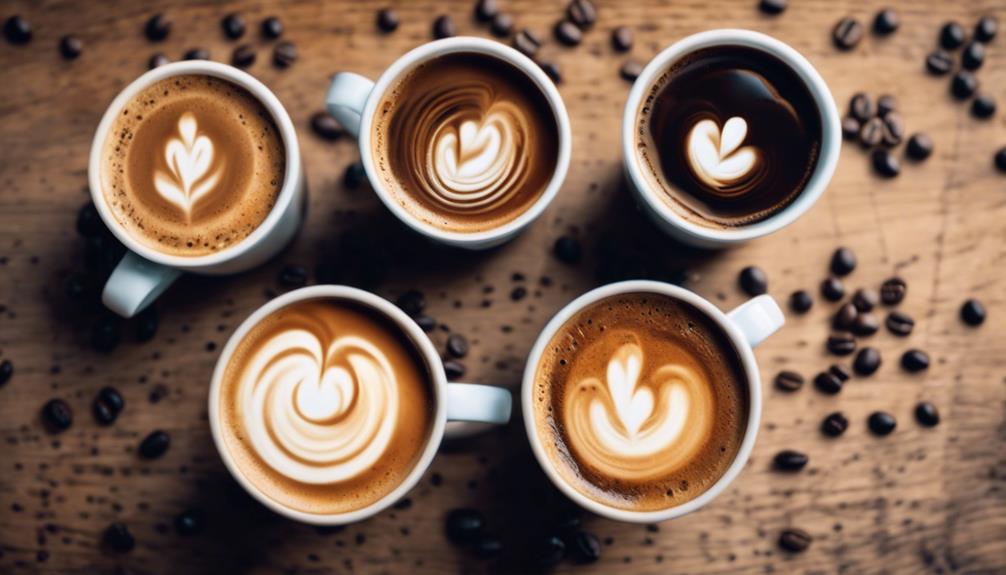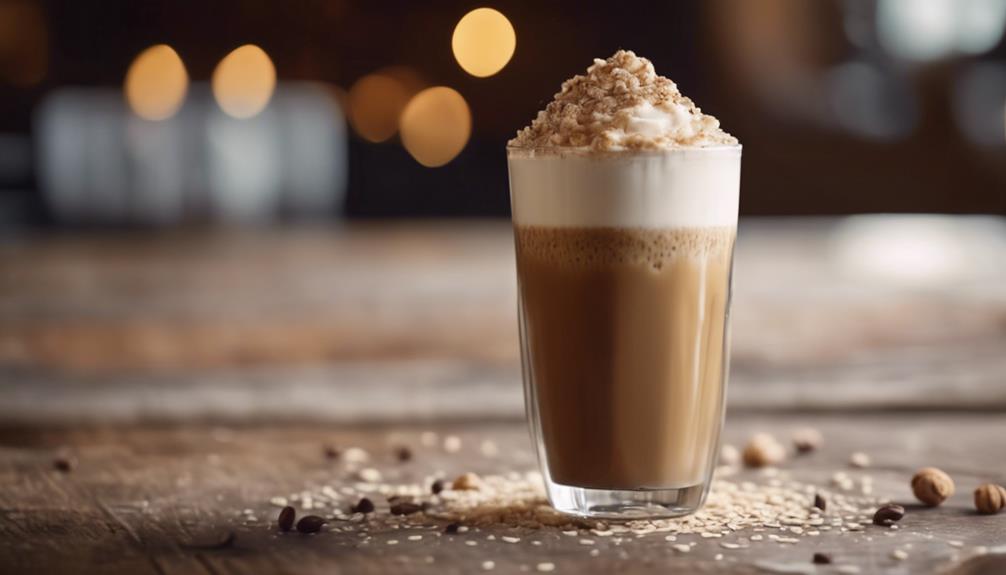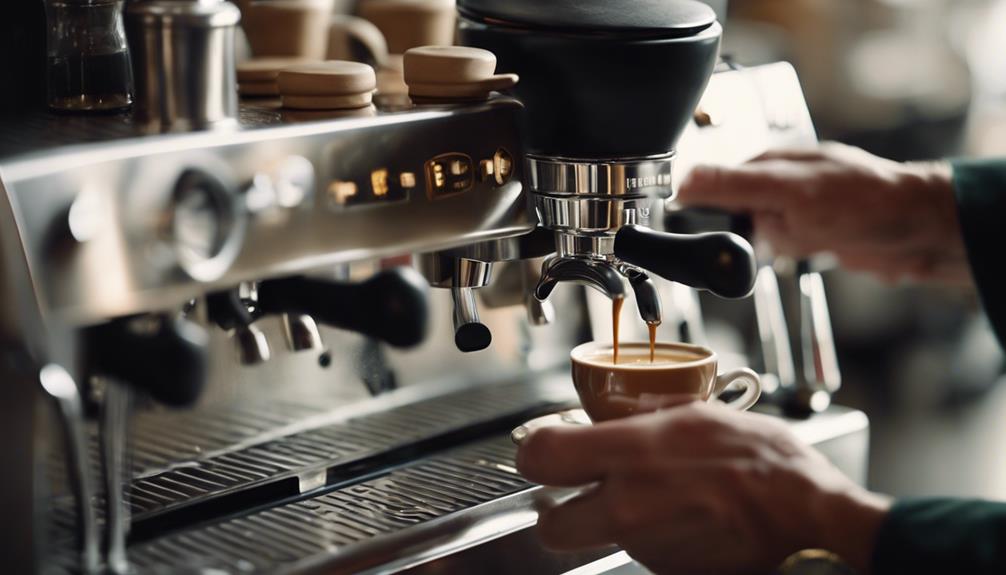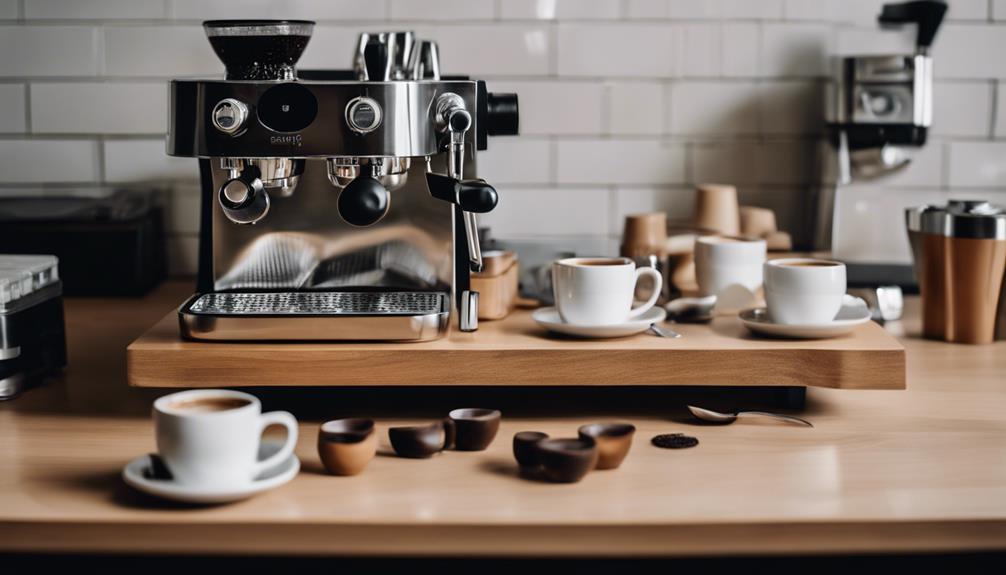You are on the verge of entering a world of bold flavors and intense aromas through a variety of espresso drinks that will enhance your coffee experience. From the traditional latte and cappuccino to the robust macchiato and indulgent mocha, each beverage provides a distinct flavor profile. For those seeking a stronger kick, consider trying an Americano or experimenting with flavorings like cinnamon or hazelnut. Whether you are a coffee enthusiast or a beginner, there is an espresso drink just for you. As you delve into these choices, you will discover even more options to excite your taste buds.
Key Takeaways
- Try a Latte for a sweet and rich espresso drink with a 1:2 ratio of espresso to milk.
- Experience a Cappuccino, a classic drink with robust flavor, served in a smaller 5-6 oz cup.
- Indulge in a Mocha, a blend of espresso, chocolate, and steamed milk for a decadent treat.
- Discover the bold flavor of a Macchiato, featuring a shot of espresso with a dollop of foam.
Understanding Espresso Basics
Get ready to elevate your coffee game by grasping the fundamentals of espresso, a concentrated coffee beverage that's brewed by forcing hot water through finely-ground coffee at high pressure, resulting in a rich, flavorful shot.
You're about to reveal the secrets of this beloved coffee drink. To start, you'll need to understand that a standard espresso shot requires 7-9 grams of finely-ground coffee, extracted in 20-30 seconds at around 200°F (93°C) and 9 bars of pressure for ideal flavor.
The brewing process is what sets espresso apart, resulting in a lower grounds-to-water ratio that intensifies the flavor. This means you'll experience a richer, more robust taste in every shot. Plus, espresso has a higher caffeine concentration per ounce, containing approximately 64 mg of caffeine.
To achieve the best quality espresso, remember that freshly roasted beans and a fine grind are essential. By mastering these basics, you'll be well on your way to creating exceptional espresso shots with a rich flavor that will impress even the most discerning coffee connoisseurs.
Popular Espresso Drinks Explained
Now that you've mastered the art of brewing the perfect espresso shot, it's time to explore the various ways to enjoy it – and that's where popular espresso drinks come in. You're probably familiar with some of these popular types of espresso, but do you know what sets them apart? One of the most common espresso drinks is the cappuccino, which is equal parts espresso, steamed milk, and foam. If you prefer something stronger, the macchiato is an espresso with just a dollop of milk foam. And for those with a sweet tooth, the latte is the perfect choice, made with a shot of espresso and a generous amount of steamed milk. To further explore the differences between these popular espresso drinks, you can refer to an espresso drinks chart for a detailed comparison of ingredients and proportions.
Here are a few popular espresso-based drinks you should try:
- Latte: A sweet and rich morning favorite with a typical ratio of 1:2 espresso to milk.
- Cappuccino: A classic drink boasting a robust flavor, often enjoyed in a smaller 5-6 oz cup.
These drinks are just a few examples of the many ways you can enjoy your espresso.
From the bold and rich macchiato to the indulgent mocha, there's an espresso drink out there for everyone.
Espresso Vs Regular Coffee Compared

When you're deciding between an espresso and a regular coffee, you're probably wondering what sets them apart.
You'll notice a significant difference in flavor intensity, with espresso's richer taste and thicker consistency due to its unique brewing process.
As you explore the world of espresso, you'll want to contemplate the contrasts in caffeine content, brewing time, and even the type of coffee grounds used, which all impact the final product.
Flavor Intensity Difference
Comparing espresso to regular coffee, you'll notice a stark difference in flavor intensity, mainly due to their distinct brewing methods and ratios of grounds to water.
As a coffee lover, you'll appreciate the rich, concentrated taste of espresso, which is a result of its lower grounds-to-water ratio. This higher concentration of flavors is what sets espresso apart from brewed coffee.
Here are some key factors that contribute to the flavor intensity difference:
- Pressurized brewing method: Espresso's high-pressure brewing process enhances flavor extraction, creating a thick consistency and well-rounded profile that regular coffee lacks.
- Finely ground coffee: The finely ground coffee used in espresso shots allows for a more efficient extraction of oils, aromas, and tastes, resulting in a complex flavor profile.
Caffeine Content Contrast
You'll also notice a significant difference in caffeine content between espresso and regular coffee, with a standard shot of espresso packing a more concentrated caffeine punch.
While a single 1-ounce shot of espresso contains around 64 mg of caffeine, an 8-ounce cup of brewed coffee typically holds between 95 to 200 mg of caffeine. However, the key difference lies in the concentration of caffeine per ounce. Espresso boasts an impressive 30-50 mg of caffeine per ounce, whereas regular coffee averages around 12.5 mg per ounce.
This disparity in caffeine density is largely due to the brewing method. Espresso's pressurized hot water extraction process yields a more efficient caffeine extraction, contributing to its intense flavor profile.
When exploring types of espresso drinks, you'll often find that the smaller serving sizes are designed to balance out the concentrated caffeine content. In contrast, drip coffee's larger volume can lead to a higher total caffeine intake, despite its lower concentration per ounce.
As you venture into the world of espresso, be mindful of the caffeine content to find the perfect balance for your taste buds.
Brewing Process Compared
Your espresso experience starts with the brewing process, which sets it apart from regular coffee in several key ways. When you order an espresso, you're getting a concentrated coffee that's been brewed using high pressure and a precise temperature. This process enhances flavor extraction, resulting in a thicker consistency and intense flavor profile.
Here are a few key differences between the brewing process of espresso and regular coffee:
- High pressure brewing: Espresso is brewed at 9 bars of pressure, while regular coffee is brewed using gravity.
- Concentrated coffee: A single shot of espresso uses 7-9 grams of coffee to produce about 1 ounce of concentrated coffee, compared to a standard 8-ounce cup of regular coffee.
These differences in brewing process contribute to the distinct taste and caffeine concentration of espresso compared to regular coffee. With a higher caffeine concentration per ounce, espresso packs a bigger punch in a smaller serving size.
Brewing Espresso at Home Guide
To access the full potential of espresso, start by investing in a quality espresso machine that can maintain stable pressure and temperature, as this is essential for ideal extraction of flavors and oils from the coffee grounds.
You'll want to grind your coffee beans to a fine consistency, using 7-9 grams for a single shot and 14-18 grams for a double shot. This maximizes flavor extraction during the brewing process.
Pack the coffee grounds firmly and evenly in the portafilter to create a uniform puck, which helps achieve a consistent flow of water through the coffee during extraction.
Aim for a brewing time of 20-30 seconds for each shot to extract the rich flavors, aiming for a yield of 1-2 ounces of espresso with a thick crema on top.
Experiment with different high-quality, freshly roasted beans to find the perfect flavor profile.
With practice, you'll be crafting delicious espresso shots in no time – and you can take it to the next level by adding steamed milk and foam to create your favorite espresso drinks!
Customizing Espresso With Flavorings
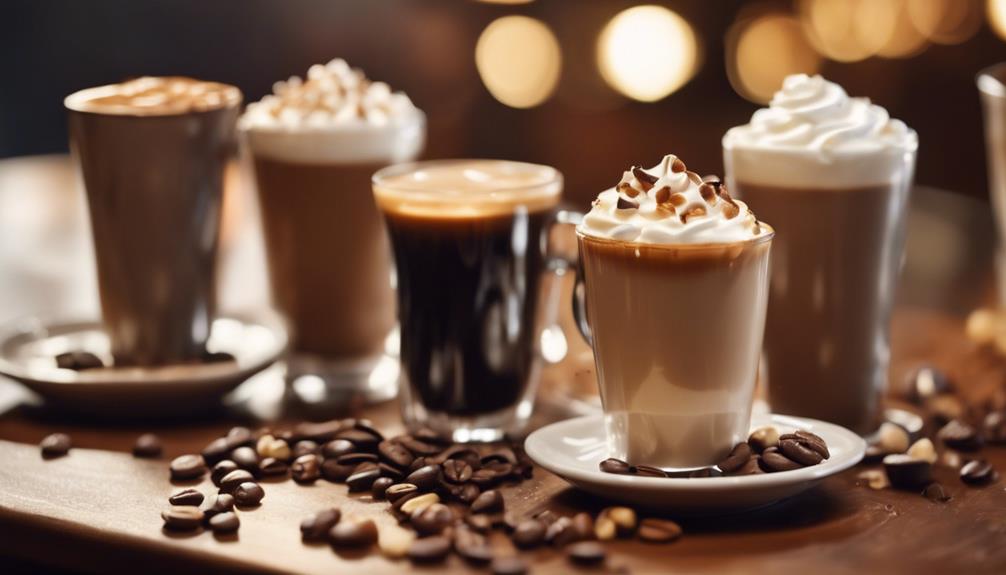
Now that you've mastered the art of brewing espresso at home, it's time to take your drinks to the next level by customizing them with flavorings.
You can experiment with various enhancers, spices, and sweet treats to create unique and delicious variations that suit your taste.
From classic flavor combinations to seasonal twists, the possibilities are endless, and we'll explore three key ways to customize your espresso drinks.
Espresso Flavor Enhancers
With a world of flavorings at your fingertips, you can transform a simple shot of espresso into a personalized masterpiece that caters to your unique taste buds. As an espresso flavor enhancer, you have the power to experiment with various flavorings to create a one-of-a-kind drink.
Add a dash of seasonal spices like pumpkin spice or cinnamon to give your espresso a warm, cozy feel.
Mix and match flavored syrups like vanilla, caramel, or hazelnut to create unique flavors that tantalize your taste buds.
Swap out traditional milk for dairy alternatives like almond milk, oat milk, or coconut milk to add a new dimension of flavor and texture.
Spiced Espresso Delights
As you explore the world of spiced espresso delights, you'll discover that adding a pinch of this or a dash of that can transform your morning pick-me-up into a truly unforgettable experience.
Adding spices like cinnamon, nutmeg, or cardamom can enhance the flavor profile of espresso drinks, offering warm and aromatic notes that complement the coffee's richness. A pinch of ground cinnamon, for instance, not only adds flavor but also provides potential health benefits, such as anti-inflammatory properties and improved blood sugar control.
If you're looking for a sweeter take, try incorporating vanilla extract or syrup to create a creamy, sweet undertone in drinks like lattes and cappuccinos. Seasonal spices, such as pumpkin spice in the fall, can elevate traditional espresso drinks like lattes and mochas, appealing to festive tastes and preferences.
Experimenting with flavored syrups, such as hazelnut or caramel, allows for endless customization of espresso beverages, catering to individual palates and creating unique coffee experiences.
With spiced espresso delights, the possibilities are endless, and you're sure to find the perfect blend to start your day off right.
Sweet Treat Additions
You can transform your espresso drinks into decadent treats by incorporating sweet and creamy flavorings that add a new dimension to the traditional coffee experience.
With a few simple additions, you can create a world of flavors that will tantalize your taste buds.
- Try adding flavored syrups like vanilla, caramel, or hazelnut to enhance the sweetness and complexity of your espresso drinks. Just 1-2 pumps per serving will do the trick!
- Get into the holiday spirit with seasonal flavors like pumpkin spice or peppermint, perfect for fall and winter months.
Exploring Espresso Machine Options
What's the best way to get started with crafting exceptional espresso drinks at home?
It all begins with choosing the right espresso machine for your needs. When selecting an espresso machine, you'll come across semi-automatic and fully automatic options.
Semi-automatic machines offer greater control over the brewing process, allowing you to adjust grind size and extraction time for personalized espresso shots. On the other hand, fully automatic machines simplify the process with one-button operation, perfect for those who want quality espresso with minimal effort.
Regardless of the type, look for a machine that maintains pressure and temperature stability, essential for ideal flavor extraction. Many espresso machines also come with milk frothing capabilities, enabling you to create creamy cappuccinos and lattes with professional-level microfoam.
With a variety of models available, you're sure to find one that suits your preferences, whether you're a fan of bold Americanos or creamy lattes.
Invest in a high-quality espresso machine, and you'll be well on your way to crafting exceptional coffee drinks at home.
Ristretto and Lungo Espresso Shots
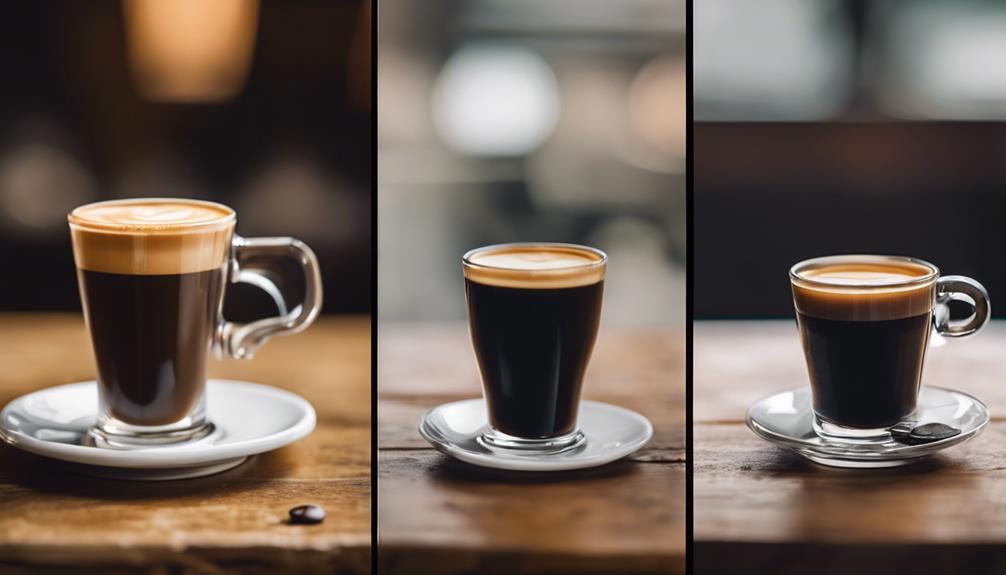
When it comes to exploring the world of espresso, two lesser-known shot options stand out for their unique flavor profiles and brewing techniques: ristretto and lungo.
These espresso shots offer distinct experiences that will tantalize your taste buds and broaden your understanding of what espresso can be.
Here are some key differences to keep in mind:
- Ristretto: A concentrated espresso shot made with less water, resulting in a sweeter and more intense flavor profile, typically served in a smaller 0.6-ounce serving.
- Lungo: Brewed with more water than a standard espresso shot, leading to a longer extraction time and a drink with a different flavor profile, and more caffeine than traditional espresso.
Both ristretto and lungo utilize the same coffee grounds, but the varying amounts of water used in each preparation method greatly alter their taste.
Ristretto is fuller and more robust, while lungo has a more diluted, yet still rich, flavor.
The caffeine content in a lungo is generally higher than that of a ristretto, making it a popular choice for those seeking an extra caffeine boost.
Doppio and Piccolo Latte Variations
Doppio and Piccolo Latte variations offer a distinct twist on traditional espresso drinks, catering to those who crave a robust coffee experience with a nuanced balance of flavors. As an espresso enthusiast, you'll appreciate the unique characteristics of each drink.
| Drink | Coffee-to-Milk Ratio | Flavor Profile |
|---|---|---|
| Doppio | 1:0 (no milk) | Bold, intense, and rich |
| Piccolo Latte | 1:3-4 (strong coffee, little milk) | Delicate balance of flavors |
| Piccolo Latte (var.) | 1:5-6 (strong coffee, more milk) | Smooth, creamy, and subtle |
The Doppio is a double shot of espresso, using 14-18 grams of finely-ground coffee to produce a stronger flavor profile. On the other hand, the Piccolo Latte combines a ristretto shot with steamed milk, creating a 3-4 oz beverage known for its delicate balance of flavors. Both drinks are popular choices for those seeking a robust coffee experience, with the Doppio offering a bolder taste and the Piccolo Latte providing a creamier texture. When trying these drinks, pay attention to the quality of the coffee beans and the precision in grinding and brewing, as these factors are essential to achieving the desired taste and aroma.
Cappuccino and Latte Differences
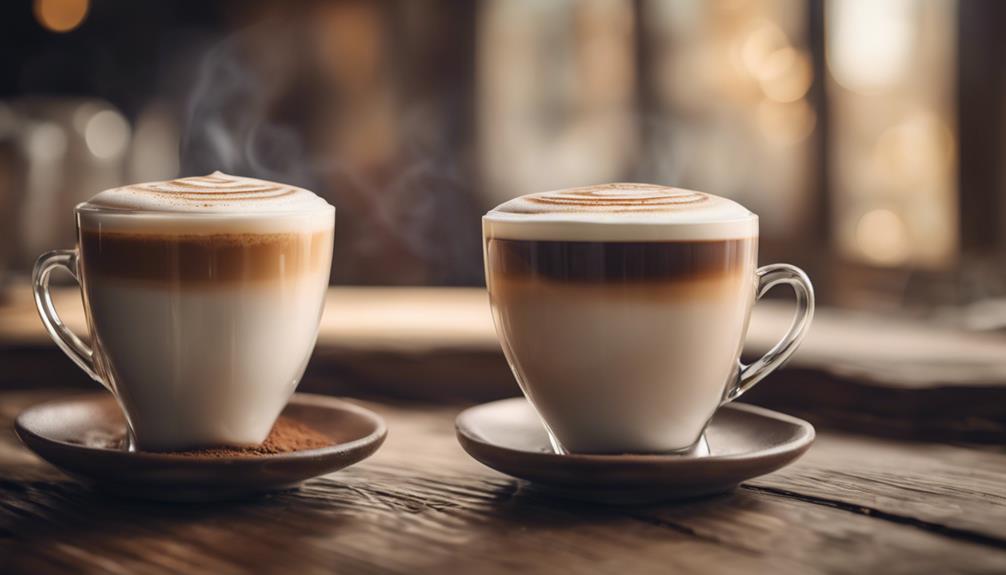
You're likely familiar with the classic duo of espresso drinks, but do you know what sets a cappuccino apart from a latte? Both are delicious, but they have distinct differences that'll make you appreciate each one even more.
A cappuccino is made with equal parts espresso, steamed milk, and milk foam, typically served in a smaller cup. On the other hand, a latte consists of one part espresso and two parts steamed milk, topped with a thin layer of foam and served in a larger cup. These different ratios considerably impact the flavor profile of each drink.
Here are some key differences to keep in mind:
- A cappuccino has a more robust flavor due to the equal balance of milk and espresso, while a latte is creamier and milder.
- Cappuccinos often have a drier texture because of the considerable amount of foam, whereas lattes have a velvety texture due to the larger volume of steamed milk.
Now that you know the differences, you can order your next cup of coffee with confidence!
Mocha and Macchiato Flavor Profiles
With a solid understanding of cappuccino and latte differences, you can now explore the rich flavors of mocha and macchiato, two espresso drinks that cater to distinct tastes and preferences.
A mocha combines bold espresso with sweet chocolate syrup and steamed milk, often topped with whipped cream, making it a dessert-like treat for those with a sweet tooth. The flavor balance in a mocha is harmonious, blending coffee's bitterness with chocolate's sweetness, resulting in a creamy and indulgent beverage.
On the other hand, an espresso macchiato features a shot of espresso 'marked' with a small amount of steamed milk or foam, emphasizing the robust flavor of espresso while adding a touch of creaminess. This drink is ideal for those who appreciate a strong coffee flavor.
Both mocha and macchiato can be customized with flavored syrups, alternative milks, or different milk frothing techniques, providing an opportunity to personalize these classic drinks to suit your individual preferences.
Frequently Asked Questions
How Many Different Espresso Drinks Are There?
You're wondering how many different espresso drinks are out there? Well, get ready to explore – there are over 40 variations, ranging from classic lattes to unique ristrettos, offering a world of flavors and textures to discover!
What Is 4 Shots of Espresso Called?
You're wondering what to call four shots of espresso? Well, in Italian, it's a 'quattro', which means four, and it's fundamentally two double shots or doppios, totaling four ounces of strong coffee that'll definitely give you a caffeine boost!
What Kind of Drinks Can You Make With an Espresso Machine?
You'll be amazed to know that 68% of coffee drinkers prefer espresso-based drinks! With an espresso machine, you can create a variety of drinks, from classics like lattes and cappuccinos to specialty drinks like macchiatos and cortados, and even iced variations and alternatives. To make the perfect espresso-based drinks, it’s important to use high-quality espresso beans and properly grind them to the right consistency. You can find various ground espresso tips online and from baristas to help you achieve the perfect flavor and crema in your drinks. With a little practice and experimentation, you’ll be able to impress your friends and family with delicious and professional-quality espresso-based beverages right from your own kitchen!
What Is the Most Popular Type of Espresso?
You're wondering what's the most popular type of espresso? Well, it's the latte, made with one shot of espresso and steamed milk, that wins hearts with its creamy texture and sweet flavor, appealing to most coffee lovers out there.
Conclusion
You've made it to the end of this espresso journey! Now, go forth and order like a pro.
Did you know that over 60% of coffee consumed in the US is espresso-based? That's a lot of caffeine!
With this newfound knowledge, you're ready to experiment and find your perfect cup.
From rich Ristrettos to velvety Lattes, the world of espresso is yours to explore.
Happy sipping!
